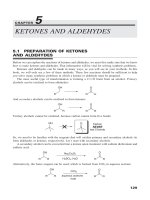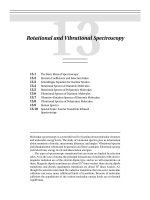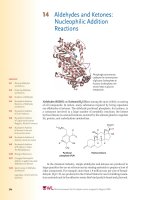Ebook Organic chemistry of explosives Part 1
Bạn đang xem bản rút gọn của tài liệu. Xem và tải ngay bản đầy đủ của tài liệu tại đây (2.99 MB, 295 trang )
Organic Chemistry of Explosives
Dr. Jai Prakash Agrawal
CChem FRSC (UK)
Former Director of Materials
Defence R&D Organisation
DRDO House, New Delhi, India
email:
Dr. Robert Dale Hodgson
Consultant Organic Chemist,
Syntech Chemical Consultancy,
Morecambe, Lancashire, UK
Website:
email:
Organic Chemistry of Explosives
Organic Chemistry of Explosives
Dr. Jai Prakash Agrawal
CChem FRSC (UK)
Former Director of Materials
Defence R&D Organisation
DRDO House, New Delhi, India
email:
Dr. Robert Dale Hodgson
Consultant Organic Chemist,
Syntech Chemical Consultancy,
Morecambe, Lancashire, UK
Website:
email:
Copyright
C
2007
John Wiley & Sons Ltd, The Atrium, Southern Gate, Chichester,
West Sussex PO19 8SQ, England
Telephone (+44) 1243 779777
Email (for orders and customer service enquiries):
Visit our Home Page on www.wiley.com
All Rights Reserved. No part of this publication may be reproduced, stored in a retrieval system or transmitted in
any form or by any means, electronic, mechanical, photocopying, recording, scanning or otherwise, except under
the terms of the Copyright, Designs and Patents Act 1988 or under the terms of a licence issued by the Copyright
Licensing Agency Ltd, 90 Tottenham Court Road, London W1T 4LP, UK, without the permission in writing of the
Publisher. Requests to the Publisher should be addressed to the Permissions Department, John Wiley & Sons Ltd,
The Atrium, Southern Gate, Chichester, West Sussex PO19 8SQ, England, or emailed to ,
or faxed to (+44) 1243 770620.
Designations used by companies to distinguish their products are often claimed as trademarks. All brand names and
product names used in this book are trade names, service marks, trademarks or registered trademarks of their
respective owners. The Publisher is not associated with any product or vendor mentioned in this book.
This publication is designed to provide accurate and authoritative information in regard to the subject matter
covered. It is sold on the understanding that the Publisher is not engaged in rendering professional services. If
professional advice or other expert assistance is required, the services of a competent professional should be sought.
The publisher and the authors make no representations or warranties with respect to the accuracy or completeness
of the contents of this work and specifically disclaim all warranties, including without limitation any implied
warranties of fitness for a particular purpose. This work is sold with the understanding that the publisher is not
engaged in rendering professional services. The advice and strategies contained herein may not be suitable for every
situation. In view of ongoing research, equipment modifications, changes in governmental regulations, and the
constant flow of information relating to the use of experimental reagents, equipment, and devices, the reader is
urged to review and evaluate the information provided in the package insert or instructions for each chemical, piece
of equipment, reagent, or device for, among other things, any changes in the instructions or indication of usage and
for added warnings and precautions. The fact that an organization or Website is referred to in this work as a citation
and/or a potential source of further information does not mean that the authors or the publisher endorse the
information the organization or Website may provide or recommendations it may make. Further, readers should be
aware that Internet Websites listed in this work may have changed or disappeared between when this work was
written and when it is read. No warranty may be created or extended by any promotional statements for this work.
Neither the publisher nor the author shall be liable for any damages arising herefrom.
Other Wiley Editorial Offices
John Wiley & Sons Inc., 111 River Street, Hoboken, NJ 07030, USA
Jossey-Bass, 989 Market Street, San Francisco, CA 94103-1741, USA
Wiley-VCH Verlag GmbH, Boschstr. 12, D-69469 Weinheim, Germany
John Wiley & Sons Australia Ltd, 42 McDougall Street, Milton, Queensland 4064, Australia
John Wiley & Sons (Asia) Pte Ltd, 2 Clementi Loop #02-01, Jin Xing Distripark, Singapore 129809
John Wiley & Sons Canada Ltd, 6045 Freemont Blvd, Mississauga, Ontario, L5R 4J3, Canada
Wiley also publishes its books in a variety of electronic formats. Some content that appears in print may not be
available in electronic books.
Library of Congress Cataloging-in-Publication Data
Agrawal, J. P.
Organic chemistry of explosives / J. P. Agrawal and R. D. Hodgson.
p. cm.
Includes bibliographical references and index.
ISBN-13: 978-0-470-02967-1 (cloth : alk. paper)
ISBN-10: 0-470-02967-6 (cloth : alk. paper)
1. Explosives. I. Hodgson, R. D. II. Title.
TP270.A36 2006
662 .201547—dc22
2006022827
British Library Cataloguing in Publication Data
A catalogue record for this book is available from the British Library
ISBN-13 978-0-470-02967-1 (HB)
ISBN-10 0-470-02967-6 (HB)
Typeset in 10/12pt Times by TechBooks, New Delhi, India
Printed and bound in Great Britain by Antony Rowe Ltd, Chippenham, Wiltshire
This book is printed on acid-free paper responsibly manufactured from sustainable forestry
in which at least two trees are planted for each one used for paper production.
Contents
Foreword
Preface
Abbreviations
Acknowledgements
Background
1 Synthetic Routes to Aliphatic C-Nitro Functionality
1.1 Introduction
1.2 Aliphatic C-nitro compounds as explosives
1.3 Direct nitration of alkanes
1.4 Addition of nitric acid, nitrogen oxides and related compounds to unsaturated
bonds
1.4.1 Nitric acid and its mixtures
1.4.2 Nitrogen dioxide
1.4.3 Dinitrogen pentoxide
1.4.4 Nitrous oxide and dinitrogen trioxide
1.4.5 Other nitrating agents
1.5 Halide displacement
1.5.1 Victor Meyer reaction
1.5.2 Modified Victor Meyer reaction
1.5.3 Ter Meer reaction
1.5.4 Displacements using nitronate salts as nucleophiles
1.6 Oxidation and nitration of C–N bonds
1.6.1 Oxidation and nitration of oximes
1.6.2 Oxidation of amines
1.6.3 Nitration of nitronate salts
1.6.4 Oxidation of pseudonitroles
1.6.5 Oxidation of isocyanates
1.6.6 Oxidation of nitrosoalkanes
1.7 Kaplan–Shechter reaction
1.8 Nitration of compounds containing acidic hydrogen
1.8.1 Alkaline nitration
1.8.2 Acidic nitration
1.9 Oxidative dimerization
page xi
xiii
xv
xxiii
xxv
1
1
2
2
3
3
4
5
6
6
7
7
9
10
13
14
14
19
21
23
23
24
24
27
27
31
32
vi
Contents
1.10 Addition and condensation reactions
1.10.1 1,2-Addition reactions
1.10.2 1,4-Addition reactions
1.10.3 Mannich reaction
1.10.4 Henry reaction
1.11 Derivatives of polynitroaliphatic alcohols
1.12 Miscellaneous
1.12.1 1,1-Diamino-2,2-dinitroethylenes
1.12.2 Other routes to aliphatic nitro compounds
1.12.3 Selective reductions
1.13 Chemical stability of polynitroaliphatic compounds
1.13.1 Reactions with mineral acids
1.13.2 Reactions with base and nucleophiles
References
33
33
35
43
44
46
49
49
50
51
51
52
52
55
2 Energetic Compounds 1: Polynitropolycycloalkanes
2.1 Caged structures as energetic materials
2.2 Cyclopropanes and spirocyclopropanes
2.3 Cyclobutanes and their derivatives
2.4 Cubanes
2.5 Homocubanes
2.6 Prismanes
2.7 Adamantanes
2.8 Polynitrobicycloalkanes
2.8.1 Norbornanes
2.8.2 Bicyclo[3.3.0]octane
2.8.3 Bicyclo[3.3.1]nonane
References
67
67
68
69
71
74
78
79
82
82
84
85
85
3 Synthetic Routes to Nitrate Esters
3.1 Nitrate esters as explosives
3.2 Nitration of the parent alcohol
3.2.1 O-Nitration with nitric acid and its mixtures
3.2.2 O-Nitration with dinitrogen tetroxide
3.2.3 O-Nitration with dinitrogen pentoxide
3.2.4 O-Nitration with nitronium salts
3.2.5 Transfer nitration
3.2.6 Other O-nitrating agents
3.3 Nucleophilic displacement with nitrate anion
3.3.1 Metathesis between alkyl halides and silver nitrate
3.3.2 Decomposition of nitratocarbonates
3.3.3 Displacement of sulfonate esters with nitrate anion
3.3.4 Displacement with mercury (I) nitrate
3.4 Nitrate esters from the ring-opening of strained oxygen heterocycles
3.4.1 Ring-opening nitration of epoxides
87
87
90
90
93
93
94
95
96
97
97
98
98
99
99
99
Contents
vii
3.4.2 1,3-Dinitrate esters from the ring-opening nitration of oxetanes with
dinitrogen pentoxide
3.4.3 Other oxygen heterocycles
3.5 Nitrodesilylation
3.6 Additions to alkenes
3.6.1 Nitric acid and its mixtures
3.6.2 Nitrogen oxides
3.6.3 Metal salts
3.6.4 Halonitroxylation
3.7 Deamination
3.8 Miscellaneous methods
3.9 Synthetic routes to some polyols and their nitrate ester derivatives
3.10 Energetic nitrate esters
References
102
103
103
104
104
105
106
106
106
107
108
112
117
4 Synthetic Routes to Aromatic C-Nitro Compounds
4.1 Introduction
4.2 Polynitroarylenes as explosives
4.3 Nitration
4.3.1 Nitration with mixed acid
4.3.2 Substrate derived reactivity
4.3.3 Effect of nitrating agent and reaction conditions on product selectivity
4.3.4 Other nitrating agents
4.3.5 Side-reactions and by-products from nitration
4.4 Nitrosation–oxidation
4.5 Nitramine rearrangement
4.6 Reaction of diazonium salts with nitrite anion
4.7 Oxidation of arylamines, arylhydroxylamines and other derivatives
4.7.1 Oxidation of arylamines and their derivatives
4.7.2 Oxidation of arylhydroxylamines and their derivatives
4.8 Nucleophilic aromatic substitution
4.8.1 Displacement of halide
4.8.2 Nitro group displacement and the reactivity of polynitroarylenes
4.8.3 Displacement of other groups
4.8.4 Synthesis of 1,3,5-triamino-2,4,6-trinitrobenzene (TATB)
4.9 The chemistry of 2,4,6-trinitrotoluene (TNT)
4.10 Conjugation and thermally insensitive explosives
References
125
125
126
128
129
131
138
139
143
144
145
148
149
149
155
157
158
167
169
172
174
176
180
5 Synthetic Routes to N-Nitro Functionality
5.1 Introduction
5.2 Nitramines, nitramides and nitrimines as explosives
5.3 Direct nitration of amines
5.3.1 Nitration under acidic conditions
5.3.2 Nitration with nonacidic reagents
191
191
192
195
195
202
viii
Contents
5.4 Nitration of chloramines
5.4.1 Nitration of dialkylchloramines
5.4.2 Nitration of alkyldichloramines
5.5 N-Nitration of amides and related compounds
5.5.1 Nitration with acidic reagents
5.5.2 Nitration with nonacidic reagents
5.6 Nitrolysis
5.6.1 Nitrolysis of amides and their derivatives
5.6.2 Nitrolysis of N-alkyl bonds
5.6.3 Nitrolysis of nitrosamines
5.7 Nitrative cleavage of other nitrogen bonds
5.8 Ring-opening nitration of strained nitrogen heterocycles
5.8.1 Aziridines
5.8.2 Azetidines
5.9 Nitrosamine oxidation
5.10 Hydrolysis of nitramides and nitroureas
5.11 Dehydration of nitrate salts
5.12 Other methods
5.13 Primary nitramines as nucleophiles
5.13.1 1,4-Michael addition reactions
5.13.2 Mannich condensation reactions
5.13.3 Condensations with formaldehyde
5.13.4 Nucleophilic displacement reactions
5.14 Aromatic nitramines
5.15 The nitrolysis of hexamine
5.15.1 The synthesis of RDX
5.15.2 The synthesis of HMX
5.15.3 Effect of reaction conditions on the nitrolysis of hexamine
5.15.4 Other nitramine products from the nitrolysis of hexamine
References
6 Energetic Compounds 2: Nitramines and Their Derivatives
6.1 Cyclopropanes
6.2 Cyclobutanes
6.3 Azetidines – 1,3,3-trinitroazetidine (TNAZ)
6.4 Cubane–based nitramines
6.5 Diazocines
6.6 Bicycles
6.7 Caged heterocycles – isowurtzitanes
6.8 Heterocyclic nitramines derived from Mannich reactions
6.9 Nitroureas
6.10 Other energetic nitramines
6.11 Energetic groups
6.11.1 Dinitramide anion
6.11.2 Alkyl N,N-dinitramines
6.11.3 N-Nitroimides
References
207
207
207
208
208
211
213
213
217
221
223
225
226
227
228
229
232
233
234
234
235
239
240
240
243
243
247
250
252
255
263
263
264
265
268
269
271
273
276
277
282
284
284
286
287
288
Contents
ix
7 Energetic Compounds 3: N-Heterocycles
7.1 Introduction
7.2 5-Membered rings – 1N – pyrroles
7.3 5-Membered rings – 2N
7.3.1 Pyrazoles
7.3.2 Imidazoles
7.3.3 1,3,4-Oxadiazoles
7.3.4 1,2,5-Oxadiazoles (furazans)
7.3.5 Benzofurazans
7.3.6 Furoxans
7.3.7 Benzofuroxans
7.4 5-Membered rings – 3N
7.4.1 Triazoles
7.4.2 Triazolones
7.4.3 Benzotriazoles
7.5 5-Membered rings – 4N
7.6 6-Membered rings – 1N – pyridines
7.7 6-Membered rings – 2N
7.8 6-Membered rings – 3N
7.9 6-Membered rings – 4N
7.10 Dibenzotetraazapentalenes
References
293
293
294
294
294
296
297
297
302
302
303
307
307
312
313
314
317
318
320
321
324
326
8 Miscellaneous Explosive Compounds
8.1 Organic azides
8.1.1 Alkyl azides
8.1.2 Aromatic azides
8.2 Peroxides
8.3 Diazophenols
8.3.1 Diazophenols from the diazotization of aminophenols
8.3.2 Diazophenols from the rearrangement of
o-nitroarylnitramines
8.4 Nitrogen-rich compounds from guanidine and its derivatives
References
333
333
333
338
339
340
340
9 Dinitrogen Pentoxide – An Eco-Friendly Nitrating Agent
9.1 Introduction
9.2 Nitrations with dinitrogen pentoxide
9.3 The chemistry of dinitrogen pentoxide
9.4 Preparation of dinitrogen pentoxide
9.5 C-nitration
9.6 N-nitration
9.7 Nitrolysis
9.8 O-nitration
9.9 Ring cleavage nitration
349
349
350
351
351
353
355
357
359
360
341
343
346
x
Contents
9.10 Selective O-nitration
9.10.1 Glycidyl nitrate and NIMMO – batch reactor verses flow reactor
9.11 Synthesis of the high performance and eco-friendly
oxidizer – ammonium dinitramide
References
Index
361
362
363
364
367
Foreword
In the past a significant amount of research worldwide was directed at the synthesis of new
energetic compounds as potential explosives or propellant ingredients. This research involved
the synthesis of many different classes of energetic compounds, including heterocycles, nitrohydrocarbons, nitrate esters, nitramines and caged compounds. The research in this area
has been reviewed many times in the past but these reviews usually concentrated on one class
of energetic compounds, e.g. nitroalkenes or nitroazoles, and except for possibly Urbanski’s
volumes on the Chemistry and Technology of Explosives, a comprehensive study of energetic
compound synthesis has not been undertaken.
The Organic Chemistry of Explosives by J. P. Agrawal and R. D. Hodgson is a comprehensive
study of the various methods to synthesize the different classes of energetic compounds along
with methods to synthesize the various explosophoric groups that predominate the field. It
is intended to read like a tutorial on energetic compound synthesis, providing a historical
perspective of the various synthetic methods used for energetic compound synthesis, along
with enough details and discussion to understand the nuances of energetic compound synthesis.
The Organic Chemistry of Explosives also provides a perspective on the possible applications of various energetic compounds, why they are interesting as explosives or propellant
ingredients, and what advantages and disadvantages they might have compared to other energetic compounds. Finally, it provides insight into the many factors an energetic compound
synthetic chemist must consider when designing new target compounds and presents the various criteria (performance, ease of synthesis, cost, sensitivity to external stimuli, and chemical
and thermal stability) that define whether a given energetic compound will be useful to the
energetic materials community.
Dr. Philip F. Pagoria
Energetic Materials Center
Lawrence Livermore National Laboratory
Livermore, CA 94550
USA
Preface
Explosives have attracted a lot of unwanted publicity over the years for their misuse in the
taking of life and the destruction of property. Explosives are perceived by most as materials
of fear and at no time is this more prevalent than in times of war. Although such concerns and
views are not unfounded, there is a bigger picture. More explosives have been used in times
of peace than in all of the wars and conflicts put together. How many of the great engineering
achievements would have been possible if not for the intervention of explosives? Blasting
and quarrying have allowed the construction of our transport links, supplied the rock and raw
materials for our buildings, and enabled the extensive mining of minerals and other essential
materials. Explosives are in fact no more than a tool and remain as some of the most fascinating
products of chemistry.
Much of the information concerning the synthesis of organic explosives, and energetic
materials in general, can be found in the form of papers and reviews in academic chemistry
journals. The Journal of Energetic Materials (USA); Propellants, Explosives, Pyrotechnics
(Germany); Combustion, Explosion and Shockwaves (Russia) and Explosives Engineering
(UK) are specialized journals for reporting the recent advances in the synthesis and technology
of energetic materials. The mainstream organic chemistry journals occasionally report on the
synthesis of energetic materials if that work has a general significance to organic chemistry.
Chemical Abstracts is an invaluable and up to date source of information on patents and publications relating to advances in energetic materials chemistry and technology. Further, there are
some national/international societies/associations in this field and their main task is to organize
annual conferences/seminars, which provide a forum to scientists, engineers, technologists
and academicians working in this area to exchange information on the latest developments.
Tenny L. Davis first published his two volumes of The Chemistry of Powder and Explosives
in 1941 and 1943, and these were subsequently merged into a single volume. This useful
work gives an overview of energetic materials synthesis in the early years. During and after
the Second World War much research was pooled into the science of energetic materials, and
consequently, the number of reported organic compounds with explosive properties increased
enormously together with our knowledge of this subject. Tadeusz Urba´nski, a Polish chemist at
the Institute of Organic Chemistry and Technology, Technical University in Warsaw, published
the four volume series of Chemistry and Technology of Explosives over the years of 1964,
1965, 1967 and 1984. This work is a wealth of knowledge for anything from the industrial and
laboratory synthesis of explosives to their physical, chemical, thermal and explosive properties.
Unfortunately, this text is now out of print and over 20 years old. As the number of reported
energetic materials continues to grow at a rapid rate, and while a number of excellent reviews
have been published to fill this knowledge gap, there is still no single text available which
is completely devoted to the synthesis of energetic materials from the simplest mixed acid
xiv
Preface
nitration to the synthesis of modern high performance explosives via dinitrogen pentoxide
nitration methodology.
For a long time, a reference/text book has been needed which provides detailed information
on the synthetic routes to a wide range of energetic materials. The objective of this book is to
fill this gap in the literature. The Organic Chemistry of Explosives is a text of pure chemistry
which condenses together all the synthetic methods and routes available for the synthesis of
organic explosives into one volume. This book is a reference source for chemists working in
the field of energetic materials and all those with an interest in the chemistry of nitramines,
nitro compounds, nitrate esters and nitration in general. We assume the readers to be new to
the chemistry of explosives and so discuss everything from the simplest mixed acid nitration of
toluene to the complex synthesis of caged nitro compounds. In doing so, we believe students
with a sound knowledge of the basics of organic chemistry will also find this book of value.
While writing this book our approach has been to focus on synthetic methods and use
individual synthesis to supplement the discussion rather than bombarding the readers with
a near endless list of syntheses. This strikes at the fundamental principles used for energetic
materials synthesis and we believe this will be more helpful to the readers. This brings us to the
most important class of reaction used for energetic materials synthesis: that of nitration, which
is the most widely studied and well understood of any reaction class in organic chemistry. A
considerable proportion of this book is devoted to nitration. The books/papers/reviews listed
under Acknowledgements were invaluable in the writing of this manuscript and we would
recommend the reading of these for further understanding and details of nitration chemistry.
The Organic Chemistry of Explosives is split into nine well-defined chapters, based on the
observation that explosive properties are imparted into a compound by the presence of certain
functional groups. Chapters 1, 3, 4 and 5 discuss the methods which can be used to introduce
C-nitro, O-nitro, and N -nitro functionality into organic compounds; the advantages and disadvantages of each synthetic method or route is discussed, together with the scope and limitations,
aided with numerous examples in the form of text, reaction diagrams and tables. Chapters 2,
6 and 7 discuss the synthesis of energetic compounds in the form of polynitropolycycloalkanes, caged and strained nitramines, and N -heterocycles respectively. Chapter 8 discusses the
synthesis of explosives containing functionality less widely encountered, including: organic
azides, peroxides, diazophenols, and energetic compounds derived from guanidine and its
derivatives. In the end, Chapter 9 gives an account of nitration with dinitrogen pentoxide and
its likely significance for the futuristic synthesis of energetic materials.
We have tried to be as thorough as possible to include all relevant information related to the
synthesis of organic explosives and although no attempt has been made to discuss the synthesis
of every organic explosive ever made, there are several hundred compounds discussed in the
text, enough to give the reader a sound knowledge of the synthesis of explosives. It would
be quite impossible to cover all the available literature on the synthesis of explosives in a
single volume text and it is just possible that some synthetically important papers might have
been overlooked and we apologize for this. The readers are requested to inform us about such
omissions which would be greatly appreciated and included in the next edition of this book.
We hope that this book will contribute to provide organic chemists with a comprehensive
knowledge of the synthetic routes to explosives and especially those that form the basis of
worldwide chemical industries.
J. P. Agrawal
R. D. Hodgson
Abbreviations
Ac
ADN
ADNBF
n-Am
AMMO
ANF
ANFO
ANPy
ANPyO
ANPz
ANTA
ANTZ
aq
ARDEC
ATA
ATNI
ATTz
Aza-TACOT
AZTC
B:
BAEA
BAMO
BDNPA
BDNPF
Bicyclo-HMX
Bn
BOC
BPABF
BPAF
BSX
BT
BTATNB
BTDAONAB
BTTN
BTX
Acetyl [CH3 CO]
Ammonium dinitramide
7-Amino-4,6-dinitrobenzofuroxan
normal-Amyl [CH3 (CH2 )4 ]
3-Azidomethyl-3-methyloxetane
3-Amino-4-nitrofurazan
Ammonium nitrate-fuel oil explosive
2,6-Diamino 3,5-dinitropyridine
2,6-Diamino-3,5-dinitropyridine-1-oxide
2,6-Diamino-3,5-dinitropyrazine
3-Amino-5-nitro-1,2,4-triazole
4-Amino-5-nitro-1,2,3-triazole
Aqueous
US Army Research, Development and Engineering Center
4-Amino-1,2,4-triazole
Ammonium 2,4,5-trinitroimidazole
6-Amino-1,2,4-triazolo[4,3-b][1,2,4,5]tetrazine
Tetranitrodipyridotetraazapentalene
1-(Azidomethyl)-3,5,7-trinitro-1,3,5,7-tetraazacyclooctane
Base
Bis(2-azidoethyl)apidate
3,3-Bis(azidomethyl)oxetane
Bis(2,2-dinitropropyl)acetal
Bis(2,2-dinitropropyl)formal
2,4,6,8-Tetranitro-2,4,6,8-tetraazabicyclo[3.3.0]octane
Benzyl [PhCH2 ]
tertiary-Butoxycarbonyl [(CH3 )3 COCO]
4,4 -Bis(picrylamino)-3,3 -bifurazan
3,4-Bis(picrylamino)furazan
1,7-Diacetoxy-2,4,6-trinitro-2,4,6-triazaheptane
1,2,4-Butanetriol
1,3-Bis(1,2,4-triazol-3-amino)-2,4,6-trinitrobenzene (SDATO)
N ,N -Bis(1,2,4-triazol-3-yl)-4,4 -diamino-2,2 ,3,3 ,5,5 ,6,6 octanitroazobenzene
1,2,4-Butanetriol trinitrate
1-Picryl-5,7-dinitro-2H -benzotriazole
xvi
Abbreviations
i-Bu
n-Bu
s-Bu
t-Bu
Bu-NENA
CAN
cat
CL-20
CMDB
conc
m-CPBA
d
DAAF
DAAT
DAAzF
DABCO
DABF
DADE
DADN
DADNBF
DAF
DAHNS
DANTNP
DAPT
DATB
DATH
DATNT
DB
DBU
DDF
DDNP
dec
DEG
DEGBAA
DEGDN
DERA
DFAP
DGDN
DIAD
dil
DINA
DINGU
DINOL
DIPAM
DiTeU
DMDO
DME
iso-Butyl [(CH3 )2 CHCH2 ]
normal-Butyl [CH3 (CH2 )3 ]
secondary-Butyl [CH3 CH2 CH(CH3 )]
tertiary-Butyl [(CH3 )3 C]
N -Butyl-2-nitroxyethylnitramine
Ceric ammonium nitrate
Catalytic
2,4,6,8,10,12-Hexanitro-2,4,6,8,10,12-hexaazaisowurtzitane (HNIW)
Composite modified double-base (propellant)
Concentrated
meta-Chloroperoxybenzoic acid
Density
4,4 -Diamino-3,3 -azoxyfurazan
3,3 -Azo-bis(6-amino-1,2,4,5-tetrazine)
4,4 -Diamino-3,3 -azofurazan
1,4-Diazabicyclo[2.2.2]octane
4,4 -Diamino-3,3 -bifurazan
1,1-Diamino-2,2-dinitroethylene (FOX-7)
1,5-Diacetyl-3,7-dinitro-1,3,5,7-tetraazacyclooctane
5,7-Diamino-4,6-dinitrobenzofuroxan
3,4-Diaminofurazan
3,3 -Diamino-2,2 ,4,4 ,6,6 -hexanitrostilbene
4,6-Bis(3-amino-5-nitro-1H -1,2,4-triazole-1-yl)-5-nitropyrimidine
3,7-Diacetyl-1,3,5,7-tetraazabicyclo[3.3.1]nonane
1,3-Diamino-2,4,6-trinitrobenzene
1,7-Diazido-2,4,6-trinitro-2,4,6-triazaheptane
3,5-Diamino-2,4,6-trinitrotoluene
Double-base (propellant)
1,8-Diazabicyclo[5.4.0]undec-7-ene
4,4 -Dinitro-3,3 -diazenofuroxan (DNAF)
2-Diazo-4,6-dinitrophenol (DINOL)
Decomposition temperature
Diethylene glycol
Diethylene glycol bis(azidoacetate) ester
Diethylene glycol dinitrate (DGDN)
Defence Evaluation and Research Agency
1,1,3,5,5-Pentanitro-1,5-bis(difluoramino)-3-azapentane
Diethylene glycol dinitrate (DEGDN)
Diisopropyl azodicarboxylate
Dilute
N -Nitrodiethanolamine dinitrate
1,4-Dinitroglycouril
2-Diazo-4,6-dinitrophenol (DDNP)
3,3 -Diamino-2,2 ,4,4 ,6,6 -hexanitrobiphenyl
Bis(2,2,2-trinitroethyl)urea
Dimethyldioxirane
1,2-Dimethyoxyethane
Abbreviations
DMF
DMSO
DNABF
C-DNAT
N -DNAT
DNAzBF
DNBF
DNBT
DNF
DNFX
2,4-DNI
DNNC
DNPP
DNT
DNTZ
DNU
DPO
DPT
EDNA
EGBAA
EGDN
EIDS
eq
Estane
Et
EWG
Explosive D
FEFO
FLSC
FOX-7
FOX-12
g
GAP
GC
gem
GLYN
GTN
HAB
HBIW
Hexyl
HHTDD
HK-55
HK-56
HMMO
HMPA
HMTD
Dimethylformamide
Dimethylsulfoxide
4,4 -Dinitro-3,3 -azoxy-bis(furazan)
5,5 -Dinitro-3,3 -azo-1,2,4-triazole
1,1 -Dinitro-3,3 -azo-1,2,4-triazole
4,4 -Dinitro-3,3 -azo-bis(furazan)
4,6-Dinitrobenzofuroxan
5,5 -Dinitro-4,4 -bis(1,2,3-triazole)
3,4-Dinitrofurazan
3,4-Dinitrofuroxan
2,4-Dinitroimidazole
1,3,5,5-Tetranitrohexahydropyrimidine
3,6-Dinitropyrazolo[4,3-c]pyrazole
Dinitrotoluene
4,5-Dinitro-1,2,3-triazole
N,N -Dinitrourea
2,5-Dipicryl-1,3,4-oxadiazole
1,5-Dinitroendomethylene-1,3,5,7-tetraazacyclooctane
Ethylenedinitramine
Ethylene glycol bis(azidoacetate) ester
Ethylene glycol dinitrate
Extremely insensitive detonating substance
Equivalent
Poly(urethane-ester-MDI) binder (Goodrich)
Ethyl [CH3 CH2 ]
Electron withdrawing group
Ammonium picrate
Bis(2-fluoro-2,2-dinitroethyl)formal
Flexible linear shaped charge
1,1-Diamino-2,2-dinitroethylene (DADE)
N -Guanylurea salt of dinitramide
Gas phase
Glycidyl azide polymer
Gas chromatography
Geminal
Glycidyl nitrate
Glyceryl trinitrate (nitroglycerine)
Hexakis(azidomethyl)benzene
2,4,6,8,10,12-Hexabenzyl-2,4,6,8,10,12-hexaazaisowurtzitane
2,2 ,4,4 ,6,6 -Hexanitrodiphenylamine
2,6-Dioxo-1,3,4,5,7,8-hexanitrodecahydro-1H ,5H -diimidazo[4,5b:4 ,5 -e]pyrazine
2,4,6-Trinitro-2,4,6,8-tetraazabicyclo[3.3.0]octane-3-one
2,5,7-Trinitro-2,5,7,9-tetraazabicyclo[4.3.0]nonane-8-one
3-Hydroxymethyl-3-methyloxetane
Hexamethylphosphoramide
Hexamethylenetriperoxidediamine
xvii
xviii
Abbreviations
HMX
HNAB
HNF
HNFX
HNIW
HNS
HNTP
Hr
HTPB
ICI
IHE
IHNX
IR
K-55
K-56
K-6
Kel-F800
1,3,5,7-Tetranitro-1,3,5,7-tetraazacyclooctane
2,2 ,4,4 ,6,6 -Hexanitroazobenzene
Hydrazinium nitroformate
3,3,7,7-Tetrakis(difluoramino)octahydro-1,5-dinitro-1,5-diazocine
2,4,6,8,10,12-Hexanitro-2,4,6,8,10,12-hexaazaisowurtzitane (CL-20)
2,2 ,4,4 ,6,6 -Hexanitrostilbene
4 -(2 ,3 ,4 ,5 -Tetranitropyrrole)-3,5-dinitro-1,2,4-triazole
Hour
Hydroxy-terminated polybutadiene
Imperial Chemical Industries
Insensitive high explosive
2,4-Bis(5-amino-3-nitro-1,2,4-triazolyl)pyrimidine
Infrared spectroscopy
2,4,6,8-Tetranitro-2,4,6,8-tetraazabicyclo[3.3.0]octane-3-one
2,5,7,9-Tetranitro-2,5,7,9-tetraazabicyclo[4.3.0]nonane-8-one (TNABN)
1,3,5-Trinitro-2-oxo-1,3,5-triazacyclohexane (Keto-RDX)
Copolymer of vinylidene fluoride and hexafluoropropylene or
chlorotrifluoroethylene (3M Company)
Keto-RDX
1,3,5-Trinitro-2-oxo-1,3,5-triazacyclohexane (K-6)
LANL
Los Alamos National Laboratory
LAX-112
3,6-Diamino-1,2,4,5-tetrazine-2,5-dioxide
LDA
Lithium diisopropylamine
liq
Liquid phase
LLM-101
3,6-Dinitro-1,2,4,5-cyclohexanetetrol 1,4-dinitrate
LLM-105
2,6-Diamino-3,5-dinitropyrazine-1-oxide
LLM-116
4-Amino-3,5-dinitropyrazole
LLM-119
1,4-Diamino-3,6-dinitropyrazolo[4,3-c]pyrazole
LLNL
Lawrence Livermore National Laboratory
LOVA
Low vulnerability ammunition
mMeta
MDI
4,4 -Methylenebis(phenyl isocyanate)
Me
Methyl [CH3 ]
MEK
Methylethylketone
Methyl Tris-X 2,4,6-Tris(2-methyl-2-nitroxyethylnitramino)-1,3,5-triazine
mins
Minutes
MNT
Mononitrotoluene
m.p.
Melting point
MPa
Mega Pascal
Ms
Mesyl or methanesulfonate [CH3 SO2 ]
MTN
Metriol trinitrate or 1,1,1-tris(hydroxymethyl)ethane trinitrate
NAWC
Naval Air Warfare Center
NBS
N -Bromosuccinimide
NC
Nitrocellulose
NENA
Nitroxyethylnitramines
NENO
N,N -Dinitro-N,N -bis(2-hydroxyethyl)oxamide dinitrate
NG
Nitroglycerine
NHTPB
Nitrated hydroxy-terminated polybutadiene
Abbreviations
xix
NIMMO
3-Nitratomethyl-3-methyloxetane
NMHP
5-(Nitratomethyl)-1,3,5-trinitrohexahydropyrimidine
NMP
N -Methylpyrrolidinone
NMR
Nuclear magnetic resonance
NONA
2,2 ,2 ,4,4 ,4 ,6,6 ,6 -Nonanitro-m-terphenyl
NOTO
5-[4-Nitro-(1,2,5)oxadiazolyl]-5H -[1,2,3]triazolo[4,5-c][1,2,5]oxadiazole
Ns
Nosyl or 4-nitrobenzenesulphonyl [4-NO2 C6 H4 SO2 ]
NSWC
Naval Surface Warfare Center
NTO
3-Nitro-1,2,4-triazol-5-one
Nu
Nucleophile
oOrtho
ONC
Octanitrocubane
o/ pOrtho/para ratio
pPara
PADNT
4-Picrylamino-2,6-dinitrotoluene
PADP
2,6-Bis(picrylazo)-3,5-dinitropyridine
PANT
4-Picrylamino-5-nitro-1,2,3-triazole
PAT
5-Picrylamino-1,2,3,4-tetrazole
PATO
3-Picrylamino-1,2,4-triazole
PBX
Plastic bonded explosive
PCC
Pyridinium chlorochromate
PCX
3,5-Dinitro-3,5-diazapiperidinium nitrate
PDADN
2,2-Bis(azidomethyl)-1,3-propanediol dinitrate
PDDN
1,2-Propanediol dinitrate
Pentryl
1-(2-Nitroxyethylnitramino)-2,4,6-trinitrobenzene
PETKAA
Pentaerythritol tetrakis(azidoacetate) ester
PETN
Pentaerythritol tetranitrate
Ph
Phenyl [C6 H5 ]
Picramide
2,4,6-Trinitroaniline
Picryl
2,4,6-Trinitrophenyl [2,4,6-(NO2 )3 C6 H2 ]
PL-1
2,4,6-Tris(3 ,5 -diamino-2 ,4 ,6 -trinitrophenylamino)-1,3,5-triazine
PNP
Polynitrophenylene
Poly[AMMO] Poly[3-azidomethyl-3-methyloxetane]
Poly[BAMO]
Poly[3,3-bis(azidomethyl)oxetane]
Poly-CDN
Nitrated cyclodextrin polymers
Poly[GYLN]
Poly[glycidyl nitrate]
Poly[NIMMO] Poly[3-nitratomethyl-3-methyloxetane]
PPA
Polyphosphoric acid
i-Pr
iso-Propyl [(CH3 )2 CH]
n-Pr
normal-Propyl [CH3 CH2 CH2 ]
PRAN
2-(5-Amino-3-nitro-1,2,4-triazolyl)-3,5-dinitropyridine
Pyr
Pyridine
PYX
2,6-Bis(picrylamino)-3,5-dinitropyridine
R
Alkyl group (unless otherwise stated)
RDX
1,3,5-Trinitro-1,3,5-triazacyclohexane
R-salt
1,3,5-Trinitroso-1,3,5-triazacyclohexane
SAT
5,5 -Styphnylamino-1,2,3,4-tetrazole
xx
Abbreviations
SDATO
1,3-Bis(1,2,4-triazol-3-amino)-2,4,6-trinitrobenzene (BTATNB)
SNPE
Societe Nationale des Poudres et Explosifs
Styphnic acid 2,4,6-Trinitroresorcinol
TACOT
Tetranitrodibenzotetraazapentalene
TADBIW
2,6,8,12-Tetraacetyl-4,10-dibenzyl-2,4,6,8,10,12-hexaazaisowurtzitane
TAIW
2,6,8,12-Tetraacetyl-2,4,6,8,10,12-hexaazaisowurtzitane
TAT
1,3,5,7-Tetraacetyl-1,3,5,7-tetraazacyclooctane
TATB
1,3,5-Triamino-2,4,6-trinitrobenzene
TATP
Triacetone triperoxide
TAX
1-Acetyl-3,5-dinitro-1,3,5-triazacyclohexane
TBDMS
tertiary-Butyldimethylsilyl [Me3 CSiMe2 ]
TBHP
tertiary-Butylhydroperoxide
TBS
tertiary-Butyldimethylsilyl [Me3 CSiMe2 ]
TBTDO
1,2,3,4-Tetrazino[5,6- f ]benzo-1,2,3,4-tetrazine 1,3,7,9-tetra-N -oxide
TEG
Triethylene glycol
TEGDN
Triethylene glycol dinitrate
Tert
Tertiary
Tetryl
N ,2,4,6-Tetranitro-N -methylaniline
TEX
4,10-Dinitro-4,10-diaza-2,6,8,12-tetraoxaisowurtzitane
Tf
triflyl or trifluoromethanesulfonyl [CF3 SO2 ]
TFA
Trifluoroacetic acid
TFAA
Trifluoroacetic anhydride
THF
Tetrahydrofuran
THP
Tetrahydropyran
TIPS
Triisopropylsilyl [(Me2 CH)3 Si]
TMHI
1,1,1-Trimethylhydrazinium iodide
TMNTA
1,1,1-Tris(hydroxymethyl)nitromethane tris(azidoacetate) ester
TMS
Trimethylsilyl [(CH3 )3 Si]
TNABN
2,5,7,9-Tetranitro-2,5,7,9-tetraazabicyclo[4.3.0]nonane-8-one (K-56)
TNAD
trans-1,4,5,8-Tetranitro-1,4,5,8-tetrazadecalin
TNAZ
1,3,3-Trinitroazetidine
TNB
2,4,6-Trinitrobenzene
TNBT
2,2 ,4,4 -Tetranitro-bis(1,3,4-triazole)
TNC
1,3,5,7-Tetranitrocubane
TNENG
N -Nitro-N -(2,2,2-trinitroethyl)guanidine
TNFX
3,3-Bis(difluoramino)octahydro-1,5,7,7-tetranitro-1,5-diazocine
TNGU
1,3,4,6-Tetranitroglycouril
TNHP
1,3,5-Trinitrohexahydropyrimidine
TNI
2,4,5-Trinitroimidazole
TNPDU
2,4,6,8-Tetranitro-2,4,6,8-tetraazabicyclo[3.3.1]nonane-3,7-dione or
tetranitropropanediurea
TNT
2,4,6-Trinitrotoluene
TNX
2,4,6-Trinitroxylene
TPM
2,4,6-Tris(picrylamino)-1,3,5-triazine
TRAT
1,3,5-Triacetyl-1,3,5-triazacyclohexane
Tris-X
2,4,6-Tris(2-nitroxyethylnitramino)-1,3,5-triazine
Triton-B
Benzyltrimethylammonium hydroxide
Abbreviations
Ts
UDMH
vic
Viton
VNS
VOD
Tosyl or 4-toluenesulphonyl [4-MeC6 H4 SO2 ]
Unsymmetrical dimethylhydrazine (Me2 NNH2 )
Vicinal
Copolymer of vinylidene fluoride and perfluoropropylene (DuPont)
Vicarious nucleophilic substitution
Velocity of detonation
xxi









